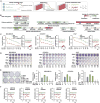Repression of BET activity sensitizes homologous recombination-proficient cancers to PARP inhibition
- PMID: 28747513
- PMCID: PMC5705017
- DOI: 10.1126/scitranslmed.aal1645
Repression of BET activity sensitizes homologous recombination-proficient cancers to PARP inhibition
Abstract
Strategies to enhance response to poly(adenosine diphosphate-ribose) polymerase inhibitor (PARPi) in primary and acquired homologous recombination (HR)-proficient tumors would be a major advance in cancer care. We used a drug synergy screen that combined a PARPi, olaparib, with 20 well-characterized epigenetic drugs and identified bromodomain and extraterminal domain inhibitors (BETis; JQ1, I-BET762, and OTX015) as drugs that acted synergistically with olaparib in HR-proficient cancer cells. Functional assays demonstrated that repressed BET activity reduces HR and thus enhances PARPi-induced DNA damage in cancer cells. We also found that inhibition or depletion of BET proteins impairs transcription of BRCA1 and RAD51, two genes essential for HR. Moreover, BETi treatment sensitized tumors to PARP inhibition in preclinical animal models of HR-proficient breast and ovarian cancers. Finally, we showed that the BRD4 gene was focally amplified across 20 types of common cancers. Combination with BETi could greatly expand the utility of PARP inhibition to patients with HR-proficient cancer.
Copyright © 2017 The Authors, some rights reserved; exclusive licensee American Association for the Advancement of Science. No claim to original U.S. Government Works.
Figures








References
-
- Lord CJ, Tutt ANJ, Ashworth A. Synthetic lethality and cancer therapy: Lessons learned from the development of PARP inhibitors. Annu Rev Med. 2015;66:455–470. - PubMed
-
- Pommier Y, O'Connor MJ, de Bono J. Laying a trap to kill cancer cells: PARP inhibitors and their mechanisms of action. Sci Transl Med. 2016;8:362ps17. - PubMed
MeSH terms
Substances
Grants and funding
LinkOut - more resources
Full Text Sources
Other Literature Sources
Research Materials
Miscellaneous

